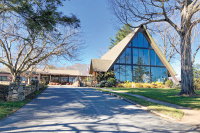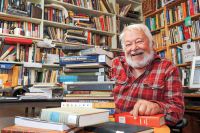Waynesville will seek loans for sewer financing

Waynesville aldermen have taken a historic step toward replacing the town’s ailing sewer plant — a step that will bind the town with up to $16 million in debt for the next 20 to 40 years.
Although aldermen don’t have much choice in replacing the plant, Dennie Martin of Asheville-based business consultancy WR Martin gave them a number of financing options, with only two really making financial sense.
“For various reasons I think it would be wise to pursue both SRF and USDA funding simultaneously,” Martin told aldermen March 12.
Martin was referring to low-interest loans from the State Revolving Fund and the United States Department of Agriculture. The SRF carries an interest rate of just below 2 percent for 20 years, and if the town qualifies, the funding will be placed “on hold” while the town completes the more onerous USDA loan application.
The USDA loan is offered at a still-competitive 3.8 percent, but with a term of 40 years, meaning smaller payments compared to the SRF loan.
The SRF submission is due in April and is automatically resubmitted in September if unsuccessful, and the USDA submission would be due in the fall.
Related Items
Martin opined that it was almost a “sure bet” that the town would qualify for one or both loans.
Grants, meanwhile, are few and far between nowadays according to Martin, and it doesn’t help that Haywood County is designated by the state as a Tier 3 county for purposes of economic development; that designation places the county among the state’s most prosperous, despite lingering poverty. Grant funds usually go to Tier 1 and Tier 2 counties, which are considered more economically distressed.
Alderman Jon Feichter asked Martin if the town would be eligible for funding from the Appalachian Regional Commission, but Martin said that not only are those applications submitted by Councils of Government instead of a municipality, but the grants are really only a few hundred thousand dollars.
At a Leadership Haywood panel held in Waynesville last month, Waynesville Town Manager Rob Hites told students that the town wouldn’t try for bond financing, either, because if the requisite ballot referendum failed, it would be nearly impossible to get a solid rate on any other loan — in essence, because voters said they don’t want the town to borrow.
There does remain one more option that Hites said the town will pursue, but it’s a long shot; last year, the North Carolina General Assembly made more than 30 direct appropriations to public bodies for large projects that aren’t, in many cases, affordable to smaller municipalities like Waynesville.
Although this might appear to be one of those — Waynesville’s general fund hovers around $15.1 million a year, and the sewer fund checks in at about $3.2 million a year, against the $16 million sewer plant price tag — a change in political philosophy has curtailed the practice somewhat.
“I’ve gotten lots of direct appropriations from both federal and state legislatures over my 35 years [as a manager in various N.C. towns]. There was a movement with the Tea Party movement about 10 or so years ago to end what we called ‘earmarks,’ and I haven’t received an earmark for any reason from the state or the federal government since a lot of legislatures made a promise to their constituents that they wouldn’t engage in any earmarking. In the jurisdictions I’ve worked, we ceased to get earmarks after legislators made that pledge.”
An even bigger hurdle to obtaining what would be the equivalent of a free sewer plant may be a natural disaster that happened almost a year ago, hundreds of miles away.
“I would be eager to support a direct appropriation of all or part of the $16 million but am doubtful of my success,” said Sen. Jim Davis, R-Franklin. “There are many systems that suffered damage from Hurricane Florence that would take priority I am sure.”
Hites said that from this point, the project should take about five years to complete, perhaps slightly less.
That five-year period is broken up into different project phases, including time spent assembling loan applications and waiting on loan approval, the actual design of the plant — which could take a full year — three months for design approval, another three months to negotiate the bid process, and nearly two full years of construction.
Not a single member of the public showed up for the March 12 meeting during which aldermen passed a pair of resolutions authorizing the town to move forward; alderman Julia Boyd Freeman was absent, due to illness.









